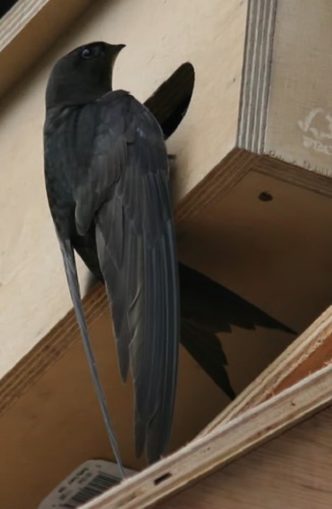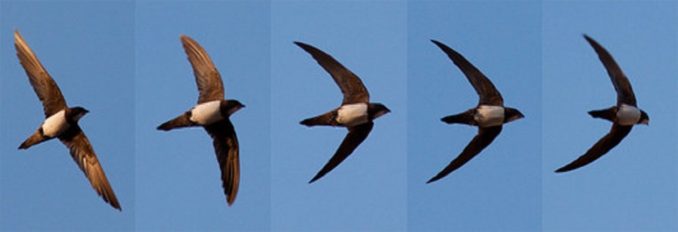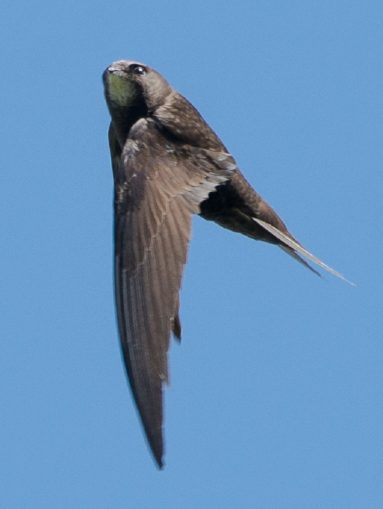Some of you may have not read any comments by myself regarding swifts during the Summer months, usually noting their arrival, their numbers and when they leave. I’m not quite sure why but for me, they are nature’s bellwether of Summer and Autumn.
The species – Apodidae is particularly old, separating from other birds around 60 million years ago. All wild birds carry some form of parasite (something to be borne in mind when cleaning or topping up your garden’s bird feeders) and it is suggested that as swifts evolved to be airborne for almost all of their lives, so their parasites too evolved as they are found on no other bird. So what makes swifts so different from other birds?
Swifts – I’ll only speak about the Common Swift as seen in the UK otherwise known as Apus Apus – hatch from eggs weighing around 3.5g which consists of 0.2g of shell. Clutches are generally 2-3 eggs and are incubated for around 3 weeks. Once hatched, chicks are fed by both parents with around 1g of food that generally consists of 500 or so insects. Rarely feeding during rain in the UK, swift chicks have adapted to a lack of food by being able enter a state of torpidity for anything up to a few days. This means that the chick’s body temperature drops and they barely move so as to conserve as much energy as possible whereas chicks of other birds would die within hours. One other bird can achieve this, the hummingbird and the 2 are related. This therefore means that time between hatching and fledging can vary by up to 3 weeks depending on food availability.

Once the chicks reach about 4 weeks old (ideally), they exercise their wings by using them to lift their bodies in the air. This increases blood flow which improves nutrients to the wings and exercises muscles for what will eventually be a life almost all of which will be on the wing.
When ready to fledge, swifts head out and fall to earth – nests are usually fairly high up – and they either fly or die. Once they leave the nest, they are on their own with that being the end of any parental involvement.
There is some dispute as to what happens next. Some say that once fledged, they head straight back to Africa. Others say that they stay in the UK for a while and fly around their local area looking for suitable nesting places whilst still learning to fly. I must say that I agree with the latter. I once witnessed 40 or more swifts flying in a circle overhead. They were flying fast and in a single line as though they were orienting themselves for when they return. This was a spectacular sight that went on for five or more minutes.
Usually in the last week of July or the first week of August, they leave but not as a group. Instead, they leave in small numbers, making their way back to Africa – a journey of 8-8000 miles at high altitudes, often above 10,000 ft. They live not on flies but spiders that move simply by spinning a line of web and using this as a sail as well as other small insects.
Once in Africa, their feeding habits change. Whereas in the UK, they avoid rain as insects tend to stay at home, in Africa, they head for rainstorms as this brings insects out. Their flying speed when feeding is said to be around 25 mph however, when trying to find a mate, their speed and aerobatic abilities are the key factors with speeds of diving swifts being recorded at over 180 mph.

After 9 months in Africa, swifts then make the return journey ‘home’ to Britain however they do not reach sexual maturity until they are 2 or 3. Once ready, they will mate on the wing so the first time that a swift will land will be when it is 2 or 3 years old, back in the area of its birth, ready to raise a family of its own.
Nests are made of bits and pieces that the bird must pick up whilst flying and these are stuck together using spittle and unfortunately are the central ingredient to birds’ nest soup.
I was fortunate enough to be sitting by a large pond one Summer when I spotted swifts drinking. As they only land for raising their young, their drinking methods have been adapted. They fly at high level then drop down in a method that pilots would refer to as a Khe Sanh approach and level out just above the water. They open their beaks and scoop up water before climbing like a home sick angel. This obviously requires excellent coordination so as not to impact the pond or to collide with other birds.
When back in Blighty, they may be seen up high at all times of the night. These birds are generally sexually immature whereas their elders are at home with the kids.. as it were and so the cycle continues.
As I type this, sadly, the skies have gone quiet. They have left Britain to make their way back to Africa for the next 9 months and I for one, cannot wait for their return.
I’ll leave you with a few words from Ted Hughes:
They’ve made it again,
Which means the globe’s still working, the Creation’s
Still waking refreshed, our summer’s
Still all to come –
And here they are, here they are again
Erupting across yard stones
Shrapnel-scatter terror. Frog-gapers,
Speedway goggles, international mobsters

© Ratcatcher 2019
Audio file



